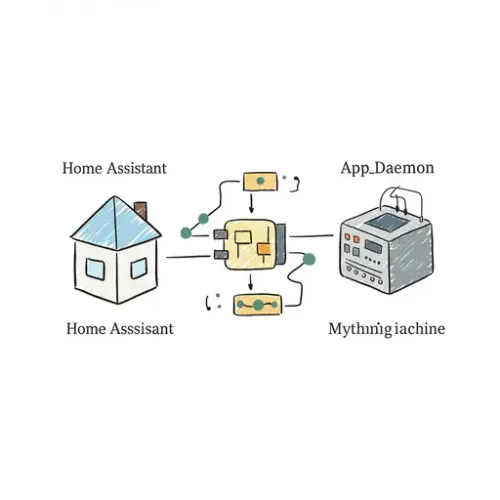Beyond YAML: Mastering Python-Powered Stateful Automations with AppDaemon in Home Assistant

NGC 224
DIY Smart Home Creator
Many Home Assistant users eventually hit a wall with YAML automations. While powerful for simple "if X then Y" scenarios, they quickly become unwieldy and difficult to debug for complex, stateful logic. Imagine needing an automation to not just turn lights on, but to remember the previous state, adapt to various conditions like time of day, occupancy, and ambient light, and only act if specific sequences of events occur. Node-RED offers a visual alternative, but even it can become complex for deeply nested, stateful decision trees. This is where AppDaemon shines.
AppDaemon is a flexible, standalone Python runtime for Home Assistant that empowers you to write custom, event-driven applications (apps) in Python. It's ideal for building robust, maintainable, and highly complex automations, virtual devices, and custom integrations that go far beyond what's practical with standard YAML. If you're a tech enthusiast, a DIY maker comfortable with Python, or a professional integrator seeking to elevate your Home Assistant setup, AppDaemon offers unparalleled control and flexibility for crafting truly intelligent and responsive smart home experiences.
Step-by-Step Setup: Integrating AppDaemon with Home Assistant
Getting AppDaemon up and running typically involves installing it as a Home Assistant Add-on. This is the easiest route for most users running HAOS or Supervised. For Docker or bare-metal installations, the process is similar but involves manual container/service setup.
1. Install the AppDaemon Add-on
Navigate to your Home Assistant UI. Go to Settings > Add-ons > Add-on Store. Search for "AppDaemon" and click on it. Then click Install.
(Screenshot Placeholder: Home Assistant Add-on Store showing AppDaemon)
2. Configure AppDaemon to Connect to Home Assistant
After installation, go to the Configuration tab of the AppDaemon add-on. You'll need to set up the connection details for your Home Assistant instance. The minimum configuration looks like this:
appdaemon:
# Base URL of your Home Assistant instance (e.g., http://homeassistant.local:8123)
ha_url: http://homeassistant.local:8123
# A long-lived access token from Home Assistant (Settings -> People -> Users -> Your User -> Create Token)
ha_key: <YOUR_LONG_LIVED_ACCESS_TOKEN>
# If you need AppDaemon's dashboard or other external access:
# http_port: 5050
log:
logfile: STDOUT
errorfile: STDERR
Important: Replace http://homeassistant.local:8123 with your actual Home Assistant URL and <YOUR_LONG_LIVED_ACCESS_TOKEN> with a newly generated Long-Lived Access Token. To generate a token: In Home Assistant, go to Settings > People > Users, select your user, scroll down to "Long-Lived Access Tokens", and click "CREATE TOKEN". Copy it immediately.
(Screenshot Placeholder: Home Assistant User Profile showing Long-Lived Access Tokens section)
3. Create Your First AppDaemon App
Once configured, start the AppDaemon add-on. After it starts, use the file editor (if installed) or Samba/SSH to create files within the /config/appdaemon/apps directory.
Create a new file named hello_world.py inside /config/appdaemon/apps with the following content:
# apps/hello_world.py
import appdaemon.plugins.hass.hassapi as hass
class HelloWorld(hass.Hass):
def initialize(self):
self.log("Hello from AppDaemon!")
self.listen_state(self.light_monitor, "light.kitchen_light", new="on")
def light_monitor(self, entity, attribute, old, new, kwargs):
self.log(f"Kitchen light turned {new}!")
self.turn_on("light.bedroom_light") # Example: turn on another light
Now, create a corresponding YAML configuration file for this app: apps/hello_world.yaml:
# apps/hello_world.yaml
hello_world:
module: hello_world
class: HelloWorld
Restart the AppDaemon add-on. Check the AppDaemon logs (available in the add-on's Log tab). You should see "Hello from AppDaemon!" and subsequent messages when your kitchen light turns on.
(Screenshot Placeholder: AppDaemon Add-on Logs showing "Hello from AppDaemon!")
Troubleshooting Common AppDaemon Issues
Even with careful setup, you might encounter issues. Here's how to debug them:
1. AppDaemon Fails to Connect to Home Assistant
- Check
ha_url: Ensure it's correct (e.g.,http://homeassistant.local:8123). - Verify
ha_key: Is the Long-Lived Access Token correct and still valid? Regenerate if unsure. - Network: If AppDaemon is running separately, ensure no firewall blocks port 8123.
- AppDaemon Logs: Always check the AppDaemon add-on's Log tab for connection errors.
2. Apps Not Loading or Crashing
- Syntax Errors: Python is strict about indentation. Use a good text editor. Check logs for tracebacks.
- Missing
.yamlConfig: Every.pyapp needs a corresponding.yamlfile. - Incorrect
moduleorclass: Ensuremodulein.yamlmatches.pyfilename, andclassmatches the Python class name. - AppDaemon Restart: After any changes to
.pyor.yamlfiles, restart the AppDaemon add-on.
3. Unexpected Behavior or No Actions
- Logging: Sprinkle
self.log("My debug message here")to trace execution flow. - Entity IDs: Double-check that your Home Assistant entity IDs are exactly correct.
- State vs. Event: Understand the difference between
listen_state(entity attributes) andlisten_event(HA events).
Advanced Configuration and Optimization
AppDaemon offers powerful features for more complex and robust applications.
1. Using Secrets
Define secrets in /config/appdaemon/secrets.yaml:
# /config/appdaemon/secrets.yaml
my_api_key: sk_1234567890
Reference them in your apps/<app_name>.yaml:
my_external_service_app:
module: my_external_service_app
class: MyExternalServiceApp
api_key: !secret my_api_key
Then, access it in your Python app via self.args:
# apps/my_external_service_app.py
import appdaemon.plugins.hass.hassapi as hass
class MyExternalServiceApp(hass.Hass):
def initialize(self):
self.api_key = self.args["api_key"]
self.log(f"Loaded API Key: {self.api_key[:4]}...")
2. Scheduling and Timer Management
AppDaemon provides robust scheduling capabilities:
run_at(callback, time): Run at a specific time (e.g.,"22:30:00").run_daily(callback, time): Run daily at a specific time.run_every(callback, start_time, interval_in_seconds): Run repeatedly.run_in(callback, delay_in_seconds): Run once after a delay (crucial for stateful logic).
# Example: Turn off light 30 seconds after motion stops
self.cancel_timer(self.light_off_timer)
self.light_off_timer = self.run_in(self.turn_off_lights, 30)
3. Accessing Home Assistant Services and States
The hass.Hass object gives you full control over Home Assistant:
self.get_state("entity_id"): Get an entity's current state.self.call_service("domain/service", entity_id="entity.id"): Call any HA service.self.turn_on("light.entity_id", brightness=150): Convenience method.
Real-World Example: Adaptive Bathroom Lighting with State Management
Let's build a sophisticated bathroom light automation that adapts to time of day, presence, and prevents flickering.
Goal: Turn on bathroom lights upon motion if dark, adapt brightness/color based on time, keep lights on with motion, turn off after delay, and restore quickly if motion returns within a grace period (e.g., preventing lights off during a shower).
Required Entities:
binary_sensor.bathroom_motion(motion sensor)sensor.bathroom_light_level(ambient light sensor)light.bathroom_main_light(dimmable, color temperature adjustable)
apps/bathroom_adaptive_light.py:
import appdaemon.plugins.hass.hassapi as hass
import datetime
class BathroomAdaptiveLight(hass.Hass):
def initialize(self):
self.motion_sensor = self.args.get("motion_sensor", "binary_sensor.bathroom_motion")
self.light_sensor = self.args.get("light_sensor", "sensor.bathroom_light_level")
self.main_light = self.args.get("main_light", "light.bathroom_main_light")
self.light_off_delay_minutes = int(self.args.get("light_off_delay_minutes", 2))
self.darkness_threshold_lux = int(self.args.get("darkness_threshold_lux", 50))
self.grace_period_seconds = int(self.args.get("grace_period_seconds", 10))
self.motion_timer = None
self.last_off_time = None
self.previous_light_state = None
self.listen_state(self.motion_detected, self.motion_sensor, new="on")
self.listen_state(self.motion_cleared, self.motion_sensor, new="off")
self.log("Bathroom Adaptive Light Initialized.")
def motion_detected(self, entity, attribute, old, new, kwargs):
self.log("Motion detected.")
if self.motion_timer:
self.cancel_timer(self.motion_timer)
self.motion_timer = None
if self.last_off_time and (datetime.datetime.now() - self.last_off_time).total_seconds() < self.grace_period_seconds:
if self.previous_light_state:
self.log("Restoring previous light state.")
self.call_service("light/turn_on", entity_id=self.main_light, **self.previous_light_state)
else:
self.log("Grace period, no previous state. Turning on adaptively.")
self._turn_on_adaptive_light()
self.last_off_time = None
return
light_level = self.get_state(self.light_sensor)
is_dark = False
if light_level is None:
is_dark = True # Assume dark if sensor unavailable
else:
is_dark = float(light_level) < self.darkness_threshold_lux
if is_dark and self.get_state(self.main_light) == "off":
self._turn_on_adaptive_light()
else:
self.log("Light not needed or already on.")
def motion_cleared(self, entity, attribute, old, new, kwargs):
self.log("Motion cleared.")
if self.get_state(self.main_light) == "on":
self.motion_timer = self.run_in(self.turn_off_lights_callback, self.light_off_delay_minutes * 60)
self.log(f"Scheduled light turn-off in {self.light_off_delay_minutes} minutes.")
def _turn_on_adaptive_light(self):
current_hour = datetime.datetime.now().hour
brightness, kelvin = 200, 4000 # Day default
if 0 <= current_hour < 6: # Night
brightness, kelvin = 50, 2700
elif 6 <= current_hour < 9: # Morning
brightness, kelvin = 150, 3500
elif 21 <= current_hour <= 23: # Evening
brightness, kelvin = 100, 3000
current_light_state = self.get_state(self.main_light, attribute="all")
if current_light_state and current_light_state['state'] == 'on':
self.previous_light_state = {
'brightness': current_light_state['attributes'].get('brightness'),
'color_temp_kelvin': current_light_state['attributes'].get('color_temp_kelvin')
}
else:
self.previous_light_state = None
self.call_service("light/turn_on", entity_id=self.main_light, brightness=brightness, kelvin=kelvin)
self.log(f"Turning on {self.main_light} B:{brightness} K:{kelvin}.")
def turn_off_lights_callback(self, kwargs):
if self.get_state(self.motion_sensor) == "off":
current_light_state = self.get_state(self.main_light, attribute="all")
if current_light_state and current_light_state['state'] == 'on':
self.previous_light_state = {
'brightness': current_light_state['attributes'].get('brightness'),
'color_temp_kelvin': current_light_state['attributes'].get('color_temp_kelvin')
}
self.turn_off(self.main_light)
self.log(f"Turning off {self.main_light}.")
self.last_off_time = datetime.datetime.now()
else:
self.log("Motion detected during turn-off delay, rescheduling.")
self.motion_timer = self.run_in(self.turn_off_lights_callback, self.light_off_delay_minutes * 60)
apps/bathroom_adaptive_light.yaml:
bathroom_adaptive_light:
module: bathroom_adaptive_light
class: BathroomAdaptiveLight
motion_sensor: binary_sensor.bathroom_motion_sensor # Adjust to your entity ID
light_sensor: sensor.bathroom_ambient_light # Adjust to your entity ID
main_light: light.bathroom_ceiling_light # Adjust to your entity ID
light_off_delay_minutes: 3 # Wait 3 minutes after motion clears to turn off
darkness_threshold_lux: 60 # Only turn on lights if ambient light is below 60 lux
grace_period_seconds: 15 # Allow 15 seconds to restore light if motion returns after turning off
This example demonstrates:
- Stateful logic: Tracking
last_off_timeandprevious_light_statefor graceful restore. - Conditional actions: Adaptive brightness/kelvin based on time of day and ambient light.
- Timer management: Cancelling/rescheduling timers to avoid premature turn-offs.
- Configurability: Using
self.argsfor easy customization via YAML.
Best Practices for Scalable, Reliable, and Secure AppDaemon Deployments
1. Code Organization
Break down complex logic into separate functions or modules. Use standard Python imports.
2. Robust Logging & Error Handling
Use self.log() liberally for debugging. Implement try-except blocks for operations that could fail (e.g., external APIs, unavailable sensors) to prevent crashes.
3. Version Control
Treat your AppDaemon apps like a codebase. Use Git to track changes, experiment safely, and revert to previous versions.
4. Secure Your Tokens
Always use secrets.yaml for sensitive information like API keys or tokens. Never hardcode them directly into your Python files.
5. Optimize Performance
- Minimize Polls: Leverage
listen_stateandlisten_event(event-driven) instead of constant polling. - Efficient Timers: Cancel unnecessary timers. Use
run_infor short, one-shot delays.
6. Testing Strategies
For simple apps, logging is sufficient. For critical apps, consider unit tests using frameworks like unittest or pytest to test logic in isolation.
By adopting AppDaemon, you move beyond the limitations of simple automations, empowering you to build truly intelligent, adaptive, and personalized smart home experiences. The initial learning curve is steeper than YAML, but the power, flexibility, and maintainability it offers for advanced scenarios are well worth the investment.

NGC 224
Author bio: DIY Smart Home Creator
